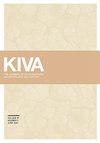Antecedents, Continuities, and Experimental Stages in a Design System: A Symmetry Analysis of Geometric Designs of the Mimbres Tradition
IF 0.4
0 ARCHAEOLOGY
Kiva-Journal of Southwestern Anthropology and History
Pub Date : 2022-09-05
DOI:10.1080/00231940.2022.2116537
引用次数: 0
Abstract
Symmetry analysis characterizes ∼1300 geometric designs on bowl interiors from five sites of the Mimbres culture tradition, AD 1000–1150, of southwestern New Mexico. The analysis reveals a distinct homogeneity in pattern structure and color on three layouts (pendant, centered and band) that, classified by plane pattern symmetries, shows a preference for four finite structures (C2, C4, D2, D4) and two one-dimensional structures (p112, pmm2) and a diversity of one-color, colored, and two-color arrangements of solid and hatched motifs. The analysis reveals common shared symmetries among neighboring cultural traditions to the south in northern Mexico, to the west among the Hohokam, and to the north among the Ancestral Pueblo of central New Mexico. Classification of the designs by symmetry enables detection of experimentation in the evolution of the design system wherein finite designs were placed within banded layouts.设计系统中的前提、连续性和实验阶段:混合传统几何设计的对称性分析
对称性分析表征了新墨西哥州西南部五个米姆布里斯文化传统遗址(公元1000-1150年)碗内部的~1300个几何设计。该分析揭示了三种布局(悬垂、居中和带状)的图案结构和颜色的明显同质性,按平面图案对称性分类,显示出对四种有限结构(C2、C4、D2、D4)和两种一维结构(p112、pmm2)的偏好,以及实体和阴影图案的单色、彩色和双色排列的多样性。该分析揭示了墨西哥北部南部、霍霍坎西部和新墨西哥州中部普韦布洛祖先北部相邻文化传统之间的共同对称性。通过对称性对设计进行分类,能够检测设计系统演变中的实验,其中有限设计被放置在带状布局中。
本文章由计算机程序翻译,如有差异,请以英文原文为准。
求助全文
约1分钟内获得全文
求助全文
来源期刊
CiteScore
0.70
自引率
33.30%
发文量
31

 求助内容:
求助内容: 应助结果提醒方式:
应助结果提醒方式:


